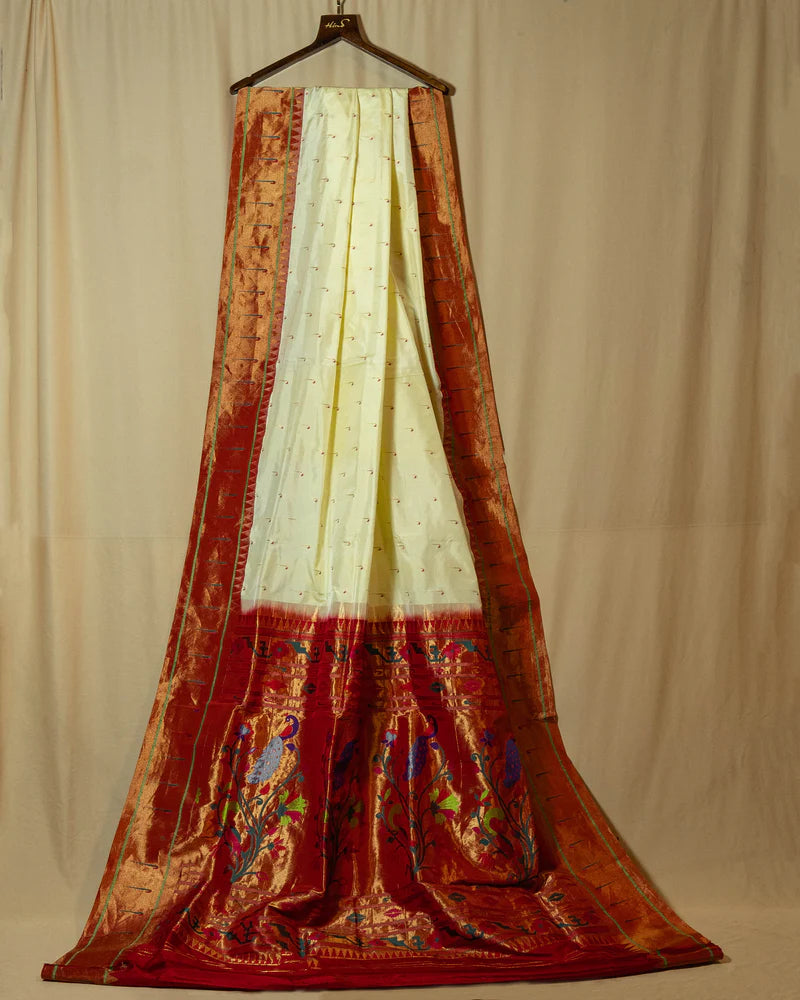How Are Paithani Sarees Made? A Journey into Intricate Weaving

How Are Paithani Sarees Made?
The making of a Paithani saree is a labor-intensive process that involves exceptional craftsmanship, patience, and dedication. Every saree is a testament to the rich cultural heritage of Maharashtra and the artistry of the weavers. Let’s delve into the intricate journey of creating these masterpieces.
1. Selecting the Materials
The foundation of a Paithani saree lies in the choice of materials:
- Silk Threads: High-quality mulberry silk is used for the body of the saree, ensuring durability and a luxurious feel.
- Zari Threads: Gold or silver-coated threads are sourced for weaving the ornate borders and pallu, adding a regal touch.
2. Dyeing the Silk
- Vibrant Colors: Silk threads are dyed using vivid hues, traditionally derived from natural dyes like turmeric, indigo, and lac.
- Color Precision: The dyeing process requires precision to achieve the characteristic bold and contrasting colors of Paithani sarees.
3. Setting the Loom
- Traditional handlooms are used for weaving, requiring meticulous setup:
- Warp and Weft Preparation: Silk threads are arranged lengthwise (warp) and crosswise (weft) to form the saree’s foundation.
- Pattu Threads: Decorative threads for the borders and pallu are aligned separately.
4. Weaving the Saree
The weaving process is the heart of Paithani craftsmanship:
- Handwoven Precision: Each saree is woven entirely by hand, taking weeks or even months to complete.
- Creating the Borders: Ornate zari borders are woven first, featuring intricate floral and geometric patterns.
- Weaving the Pallu: The pallu is adorned with signature motifs like peacocks, parrots, and lotuses. The "tapestry weaving" technique allows weavers to create detailed designs without visible reverse threads.
- Body Weaving: The main body of the saree is woven in a plain or spotted design, often with a unique iridescent effect created by interweaving two contrasting colors.
5. Special Techniques
- Kaleidoscopic Effect: Achieved by weaving warp and weft threads of different colors, giving the saree a shimmering quality.
- Reversible Borders: Traditional Paithani sarees feature identical borders on both sides, a hallmark of superior craftsmanship.
6. Adding the Finishing Touches
Once the weaving is complete:
- Quality Check: The saree is inspected for uniformity in design and finish.
- Polishing: The zari is polished to enhance its luster.
- Final Pressing: The saree is carefully ironed and folded for presentation.
7. Time and Dedication
Creating a single Paithani saree is a slow and meticulous process:
- Time Taken: Depending on the complexity of the design, it can take 1 to 6 months to complete a saree.
- Artisan Expertise: Experienced weavers dedicate their lives to mastering this intricate craft, ensuring that each saree is a unique masterpiece.
A Testament to Timeless Artistry
The making of a Paithani saree is more than just a craft—it’s an art form that celebrates tradition, creativity, and dedication. Every saree tells a story of heritage and passion, making it a prized possession for those who wear it. Owning a Paithani saree is not just about owning a garment; it’s about cherishing the legacy of India’s unparalleled textile artistry.
